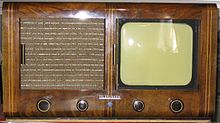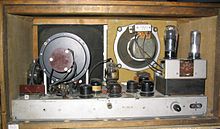German standard television receiver E 1
The standard television receiver E1 , referred to in contemporary literature as the television community receiver E1 , is a television set introduced in 1939 . In public, the device was also referred to as the “Volksfernseher”, analogous to the people's receiver for radio .
history
The Reichspostzentralamt and leading German radio manufacturers formed a working group in 1938 to further spread television in Germany . Were involved:
- Fernseh AG (from October 1939, Fernseh GmbH , subsidiary of Bosch )
- Radioaktiengesellschaft DS Loewe (from 1940 Löwe Radio AG )
- C. Lorenz AG
- Telefunken company for wireless telegraphy ltd
- TeKaDe ( Süddeutsche Telefon-Apparate-, Kabel- und Drahtwerke AG ) in Nuremberg with its Berlin subsidiary Telehor AG
The goal was to be able to bring the Reichs-Rundfunk-Gesellschaft to the market as inexpensive as possible by Christmas 1939 for the programs of the Reichs-Rundfunk-Gesellschaft that had been broadcast on the Berlin station "Paul Nipkow" since March 22, 1935 . For this purpose, license rights and production capacities were exchanged and divided among the companies involved. The devices produced by the respective manufacturers should be largely identical. A large-scale production of 10,000 televisions with a sales price of 650 Reichsmarks was planned , which, adjusted for inflation, corresponds to 2,790 euros in today's currency. In the summer of 1939, the standard television receiver was presented to the public at the 16th Great German Radio and Television Exhibition in Berlin. The planned large-scale production no longer came about due to the restrictions on civil economy after the outbreak of the Second World War. The approximately 50 completed copies of the E1 were distributed to hospitals and various departments.
technology
Compared to earlier devices, the receiver was distinguished by its significantly more economical use of components. Among other things, newly developed electron tubes that perform the functions of several individual multiple tubes also contributed to this . For this television set, the world's first rectangular picture tube, developed by Telefunken, was used, which at the time was relatively small for its size.
The 6 kV anode voltage for the picture tube was not generated via a high-voltage mains transformer, as was the case at that time, but in the line output stage. The heating voltage of the high-voltage rectifier was also generated by an additional winding on the line transformer .
The German television standard by 1938, an image with 441 lines and a frame rate of 25 Hz (25 frames per second whole or in interlaced before 50 fields per second). The image resolution of the E 1 did not yet match that of post-war television with 625 lines ( Gerber standard); but it was good enough.
Since the Reichs-Rundfunk-Gesellschaft was only broadcasting one program at that time, the E 1 was set to a fixed reception frequency ( channel ) in order to keep production costs low. For a frequency change, the plug-in input and oscillator circuits of the superimposition receiver had to be replaced by a specialist. During the breaks between broadcasts, the program of the local radio station should be broadcast on the audio channel. In order to save electrical energy , the image part could be switched off.
Some of the surviving unit receivers are still known today:
- Museum for Communication Berlin , (Telefunken, not tinkered with)
- Museum for Communication in Berlin, (Blaupunkt, incomplete)
- Museum for Communication Frankfurt , (Telefunken, with new speaker cloth, otherwise completely preserved)
- Private collection August-Peter Nehrig, (Telefunken, completely preserved)
- Deutsches Rundfunk-Museum , Berlin, (replica, without original chassis and with new speaker material)
- Depot of the telecommunications office, (manufacturer unknown, apparently intact and completely preserved)
- University of Applied Sciences Mittweida (FH) , can be seen in the video (Blaupunkt, with new speaker material, condition unknown)
- Rundfunkmuseum Fürth (original chassis with mains transformer in the exhibition)
- Rundfunkmuseum Fürth (replica, functional, for demonstration purposes)
Technical specifications
- Housing dimensions (W × H × D): 65 cm × 37 cm × 38 cm
- Image size / image diagonal: 19.5 cm × 22.5 cm / 29 cm
- Power consumption: 185 W for television reception, 60 W for audio broadcast reception
literature
- J. Georg Weiss: To the development of the standard television receiver . In: TFT issue 7/1939 ( digitized version )
- Television and sound film (magazine), issue 16, October 1939
- Hanns Günther , Heinz Richter : Advances in radio technology 5 , Franckh'sche Verlagshandlung, W. Keller & Co. , Stuttgart, 1940
Individual evidence
- ↑ This figure was based on the template: Inflation was determined, has been rounded to a full 10 euros and relates to last January.
Web links
- Detailed website with many photos of the E 1 by Eckhard Etzold
- Circuit diagram ibid.
- Rolf Wigand: Technical description of the E 1 (contemporary article in Radio-Mentor ; PDF; 295 kB)
- Scheel, JE, Urtel, Rudolf : The Telefunken tube 21/22, the deflection output stage of the communal television receiver E1 , Telefunken , August 1941 (PDF; 587 kB)


